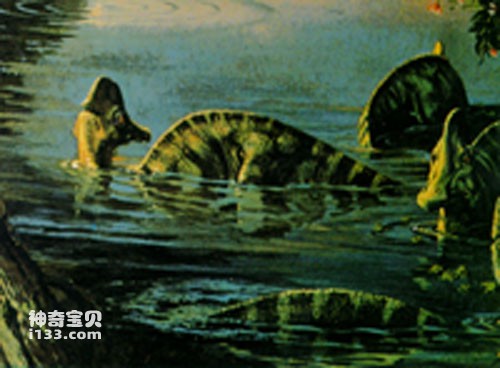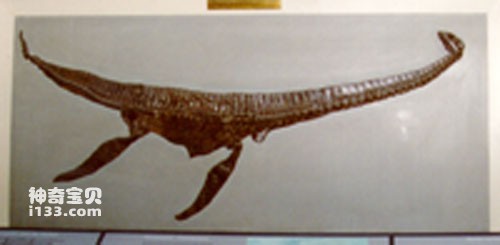The earliest skeleton fossil of a large reptile that came to the attention of the scientific community was discovered in 1770, about 40 years before Darwin was born. It was found in a chalk quarry on the St. Peter's Mountain in the village of Maastrich in the Netherlands. in ancient strata. This reptile is far different from any living animal, with a 1.33-meter-long mandible and teeth as sharp as daggers. This discovery was so surprising that the villagers quickly invited a father-son anatomist pair to identify it. Because the bones were extremely large and were buried in the layer between two strata rich in marine paleontological fossils, my father announced that they were the fossils of an ancient whale. However, the son did not agree with his father's view. Perhaps because of his keener observation of things or his more sophisticated study of anatomy, he believed that this animal was more like a lizard. But had people at that time ever seen such a huge lizard? Who has ever seen a lizard swimming in the sea? Therefore, people began to say that they had discovered the animals written in the Bible before the great flood. It was even said that this animal might be a sacrifice of the great flood!

Hadrosaurus
Above the quarry where the fossils were found was a pasture, and the rancher was a priest. He used his feudal power to seize the fossils and display them in a glass shrine in his country house. Soon, the news of the discovery of the monster during the Great Flood spread throughout the country. The famous anatomist Cuvier, who was only 26 years old at the time but was already an academician of the French Academy of Sciences, also heard the news. Napoleon, the French ruler at the time, advocated science very much and actively supported Cuvier's scientific research. He once helped him collect paleontological fossils from various places. In 1795, when Napoleon learned about the monster fossil and knew that Cuvier was interested in it, he immediately ordered one of his generals to lead an army to "liberate" the Netherlands in order to keep this precious fossil intact. The land was seized to France for Cuvier to study. This "Liberation Army" stormed into the village of Mastrici with lightning speed and occupied the country villa. However, they were disappointed. The fossil had disappeared and the glass shrine was empty.
Fortunately, the general was smart and immediately decided to offer a reward of 600 bottles of wine to track him down. A big reward must be a brave man, and several soldiers who were accustomed to robbing homes and houses quickly got the big reward, and the spoils of war were smoothly transported to Academician Cuvier's desk in Paris.

flake dragon
At this time, Academician Cuvier had just completed his research on mastodon fossils. He believes that mastodon is not the ancestor of modern Elephants-Are-Endangered.html">elephants, but an ancient elephant that has become extinct in geological history and left no descendants. So he began to try his best to convince people who did not have any understanding of evolution at the time that there had indeed been biological extinctions in history. This giant monster fossil from the village of Mastrici provides convincing evidence for his knowledge. This marine reptile is what we now know as the mosasaurus.
Shortly after this sensational incident subsided, when Darwin was 13 years old, dinosaurs were discovered again by the scientific community. This is the story of the Mantells' discovery of the Iguanodon.
Regarding Iguanodon, there were other stories that happened at that time. At that time, using the size of living iguana teeth as a reference, Professor Owen of Oxford University speculated that the length of Iguanodon was 30 to 60 meters, which was as big as half a football field! Later, Mr. Mantel and many other amateur researchers continued to dig, and it took 15 years to discover the fossils of vertebrae, ribs and many other bones. The size of these bones forced Professor Owen to change his earliest inferences and reduce the length of Iguanodon to 7 meters. These fossils also show that Iguanodon was much larger and heavier than modern monitor lizards; the structure of its sternum was similar to that of crocodiles, suggesting that it had four ventricles, which was more advanced than the three ventricles of other reptiles. Therefore, Professor Owen believes that the heart and circulatory system of Iguanodon are almost the same as those of warm-blooded vertebrates.

Mosasaurus
When Professor Owen collectively called all the huge "monster" fossils discovered at that time "dinosaurs", Queen Victoria of the United Kingdom specifically found a wildlife sculptor and asked him to sculpt a statue of Iguanodon based on Owen's research results. , for display at the Exposition held in 1851. Soon, the Iguanodon appeared in front of the Queen and the visiting dignitaries in the form of a huge and bulky animal that supported and walked on four legs.
At that time, American scientist Hayden was also collecting dinosaur fossils in the western wilderness near the Judis River in Montana, USA. He sent the collected tooth fossils to the American Academy of Natural Sciences in Philadelphia, where they were studied by Dean Reddy. Reddy discovered that these teeth were different from those of Iguanodon, so he named one of the vegetarian dinosaurs "Rough Teeth" and the other carnivorous dinosaur "Scary Teeth".
Shortly afterwards, Reddy discovered an almost complete dinosaur skeleton near Haddonfield, New Jersey, and named it Hadrosaurus. A study and comparison of the teeth revealed that the hadrosaur was closely related to the Iguanodon, even though its skeleton was far from the sculptor's image of the Iguanodon. In fact, the differences between the front and rear limbs of Hadrosaur and Iguanodon are quite different, so Reddy believes that they are not animals that support and walk on four legs at all, but are animals that can stand on their hind limbs and jump like kangaroos. animal.
Since then, the excavation of dinosaurs has become a fashion. In the following decades, excavation teams organized by major consortiums competed for dinosaur fossils, striving to satisfy the curiosity of their respective backstage bosses. As the battle for fossils becomes increasingly fierce, batches of puzzling fossils have been unearthed one after another. These authentic and immutable trophies were collected as tribute to rulers and then displayed in royal or national museums in various countries, winning praise from a stunned public and, as a result, promoting the development of paleontology.
Some fossil skeletons are truly astonishingly large. Brachiosaurus and Brontosaurus weighed more than 50 tons, which is heavier than 8 Elephants-Are-Endangered.html">elephants put together. Some scientists believe that such behemoths cannot support their own weight on land and can only live in swamps. When they are soaked in water, they can use their long necks to eat water plants and breathe through the nostrils on their heads. Air. Among the carnivorous dinosaurs, the largest is Tyrannosaurus rex. They are the largest carnivores that have ever lived on earth. Their teeth are as big as pickaxes. They stand more than 5 meters high. Their heavy tails drag on the ground. The average person standing next to them only reaches the height of their knees. How could such a behemoth not make the audience stunned.
Some dinosaurs also have special weapons or decorations on the outside of their bodies. The back and tail of Stegosaurus are covered with spikes; the skull of Ceratopsaurus has a large cervical shield toward its neck; Ankylosaurus is heavily armored; Hadrosaurus has a weird crest on its head; Iguanodon has special Nails can be used to deal with aggressive predators and dig out their eyes.
In this endless battle for fossils, a small animal with very small teeth was discovered in Solnhofen, Bavaria, Germany. It had clawed wings and long feathers, and its appearance was simply Just like the griffon in Greek mythology. Because it is considered the most primitive bird, scientists call it Archaeopteryx. Scientists studied the living habits of animals based on the characteristics of sediments and found that some reptiles, relatives of dinosaurs, are so wonderful that they really look like animals in mythology. The fantasy of the lamellar dragon living in the ocean inspired the legend of the Loch Ness monster. Some winged reptiles, pterosaurs, are only as big as a crow, and some have reached the size of a goshawk. The largest species that flies on the sea has wings as long as 15 meters, which may have reached the level that flying animals can reach. The limit. However, pterosaur wings were apparently too heavy and fragile for flight, so some scientists believe they could only glide between treetops or cliffs.
animal tags:
We created this article in conjunction with AI technology, then made sure it was fact-checked and edited by a Animals Top editor.